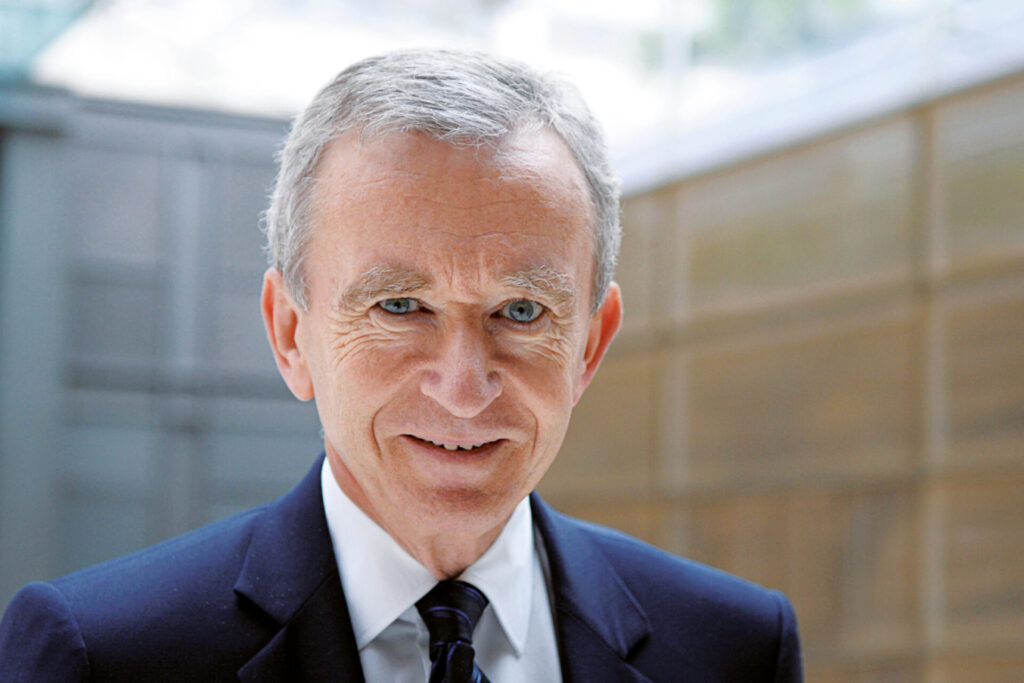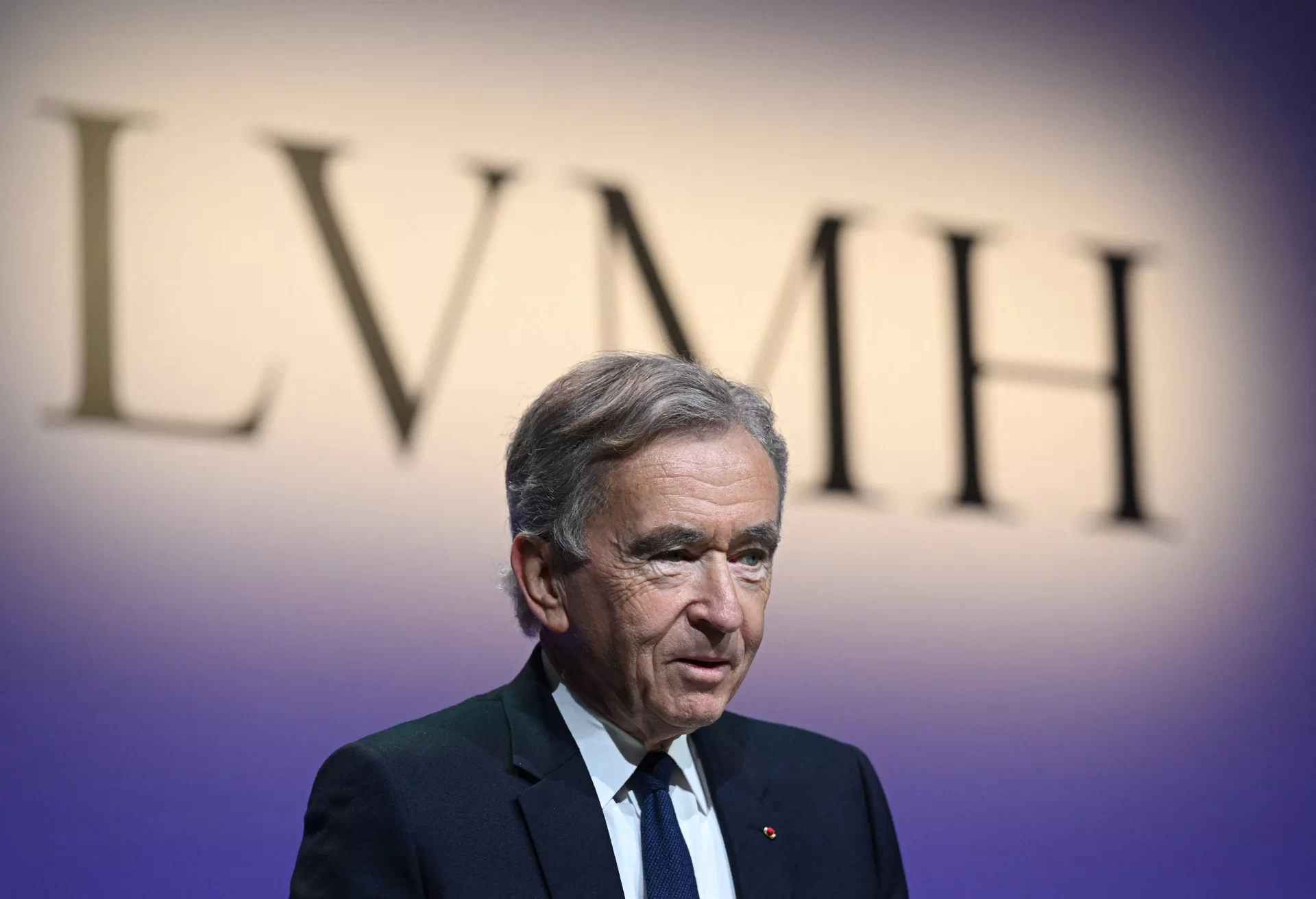LVMH, the undisputed titan of luxury, is a name that instantly evokes images of glamorous runways, opulent boutiques, and the world’s most coveted brands. From Louis Vuitton handbags to Dior perfumes, the empire spans the entire spectrum of indulgence. But while the spotlight shines on its extravagant façade, there’s a shadowy side to LVMH that’s rarely discussed—a side that’s as shocking as it is unsettling. Beneath the surface of this $400 billion empire lies a web of scandals, secrets, and controversies that threaten to unravel the polished image it has so carefully crafted.
The Rise of the “Wolf in Cashmere”
To truly understand LVMH, we must start with the man behind the empire—Bernard Arnault. Dubbed the “Wolf in Cashmere,” Arnault’s rise from a French businessman to the world’s richest man is a story of relentless ambition and ruthless strategy.

Born in 1949 in Roubaix, France, Arnault’s journey began in the most unglamorous of industries: construction. In his 20s, he took over his family’s construction business and quickly transformed it into a thriving real estate empire. But Arnault’s ambitions didn’t stop there. He had his eyes set on something far more alluring—the world of luxury.
In 1984, Arnault made his first major move into fashion by acquiring Christian Dior, a brand that was struggling at the time. This acquisition was just the beginning. Over the next few years, Arnault embarked on a shopping spree, snapping up luxury brands like Louis Vuitton and Givenchy. His strategy was simple yet effective: acquire struggling brands, revamp their image, and turn them into profit machines. It didn’t take long for Arnault to earn his infamous nickname, as critics saw him as a predator in the world of high fashion—a man who would stop at nothing to build his empire.
The Hostile Takeover That Changed Everything
Perhaps the most notorious chapter in Arnault’s rise to power is his takeover of LVMH itself. In 1987, LVMH was born out of the merger between the champagne and cognac powerhouse Moet Hennessy and the luxury fashion brand Louis Vuitton. Arnault saw an opportunity and, with the backing of the alcohol giant Guinness, began acquiring shares in LVMH. By 1988, Arnault had gained control of 43.5% of the company, becoming its largest shareholder.
But this was no friendly acquisition. The then-president of LVMH, Henry Racamier, initially welcomed Arnault, seeing him as a potential ally. However, he soon realized he had let the fox into the henhouse. Arnault’s aggressive tactics to wrest control of the company led to a bitter power struggle, which culminated in Racamier’s ousting. This move cemented Arnault’s reputation as a business mogul who plays by his own rules—a man who is as feared as he is admired.
The Sweatshops of Luxury: Exploitation in the Name of Fashion
While LVMH’s glamorous products are paraded down runways and displayed in luxurious storefronts, the origins of these items tell a far less glamorous story. In 2020, a photograph from Mumbai surfaced, revealing the harsh reality behind the production of luxury garments. Indian artisans, many of whom are Muslim men who have left their rural homes in search of work, were shown embroidering luxury items for brands like Dior and Saint Laurent. These artisans, working in poorly regulated factories, often endure up to 17-hour workdays with little to no protection.
Despite a 2016 initiative known as the Utan Pact, aimed at improving factory conditions and safeguarding workers, many of these artisans remain exploited. They toil away, producing high-end garments for a fraction of the price that consumers are willing to pay, all while receiving minimal benefits and enduring grueling working conditions. LVMH’s response to these revelations has been frustratingly vague, with the company stating that it takes such allegations seriously but failing to provide any concrete solutions.
Notre Dame: A Generous Gesture or a PR Ploy?
In April 2019, the world watched in horror as Notre Dame Cathedral was engulfed in flames. The 850-year-old landmark, a symbol of France’s cultural heritage, seemed to be lost forever. Amidst the devastation, Bernard Arnault and LVMH pledged 200 million euros towards the restoration of the cathedral—a move that was initially celebrated as a noble act of generosity.
However, the applause quickly turned into outrage when it was revealed that this donation could qualify for a significant tax deduction—up to 90%, compared to the usual 60% for charitable contributions. Critics were quick to accuse Arnault of using the tragedy for financial gain and turning a national disaster into a public relations opportunity. Arnault dismissed the controversy as “empty” and insisted that his donation was made in good faith. But the damage was done. The gesture that was meant to restore a symbol of unity instead highlighted the deep inequalities in France and the self-serving nature of corporate philanthropy.
The Tax Evasion Scandal: Patriot or Profiteer?
Bernard Arnault’s reputation took another hit in 2012 when he applied for Belgian citizenship—a move that many saw as an attempt to dodge France’s high taxes. The news sparked outrage, with critics accusing Arnault of betraying his country to protect his wealth. Despite his claims that the application was for personal reasons and not for tax avoidance, the public was not convinced. The French government even launched an investigation into his tax affairs, further fueling the controversy.
Eventually, Arnault withdrew his application for Belgian citizenship, stating that he did not want his personal situation to tarnish the image of LVMH or the French business community. But the incident left a lingering question: Is Bernard Arnault truly a patriot, or is he a man who will do whatever it takes to protect his fortune?
Animal Rights: The Cruel Cost of Luxury
As if accusations of worker exploitation and tax evasion weren’t enough, LVMH has also faced backlash from animal rights groups for its use of fur and exotic animal skins. In 2021, PETA launched a campaign against the company, condemning its use of crocodile skins in its products. The campaign featured disturbing images of crocodiles being killed for their skins, sparking widespread outrage.
LVMH defended its practices, insisting that it adheres to strict ethical standards. However, the use of exotic animal skins is seen by many as an unnecessary cruelty in an industry that could easily adopt more sustainable and humane alternatives. This controversy raises a fundamental question: In the pursuit of luxury, how much suffering are we willing to ignore?
The Price of Luxury: What Are We Really Paying For?
As consumers, we are often dazzled by the allure of luxury brands. We buy into the promise of exclusivity, quality, and prestige, often without considering the true cost of these products. Behind every Louis Vuitton handbag and Dior dress lies a complex web of exploitation, inequality, and controversy that challenges the very notion of luxury.
Bernard Arnault, with his $200 billion fortune, may be the king of this empire, but his story serves as a stark reminder that even the wealthiest and most powerful are not immune to scandal. LVMH’s success is built on a foundation of ambition and innovation, but also on practices that many would find deeply troubling.
In today’s world, where ethical consumption is becoming increasingly important, we must ask ourselves whether the glitz and glamour of luxury are worth the price we are paying—both financially and morally. As we admire the beauty of LVMH’s products, we should also demand greater transparency and accountability from the brands we choose to support.
The next time you find yourself drawn to the allure of luxury, remember that behind every sparkling display lies a story that is far less glamorous. And in a world where we have the power to choose, it’s up to us to decide what kind of story we want to support.
Also Read: LVMH: Exploring the Marketing Strategy Of Luxury Empire
To read more content like this, subscribe to our newsletter
Go to the full page to view and submit the form.

